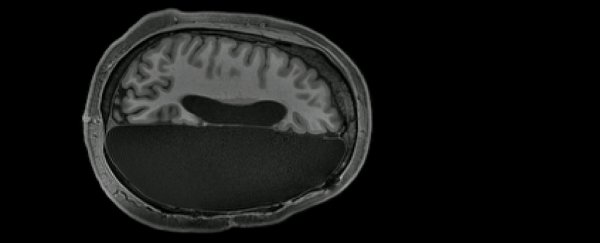Astounding stories of people living relatively normal lives with giant chunks of their brains damaged or missing often seem to defy logic. But, given the chance, our brains have an uncanny skill - to mold their abilities around the missing bits.
A new study of people missing entire halves of their brains has provided insights into how this is possible, revealing the human brain's remarkable ability to multitask when parts of it are literally absent.
"You can almost forget their condition when you meet them for the first time," said neuroscientist Dorit Kliemann from the California Institute of Technology.
"When I sit in front of the computer and see these MRI images showing only half a brain, I still marvel that the images are coming from the same human being who I just saw talking and walking and who has chosen to devote his or her time to research."
Six of the study participants had undergone the frighteningly drastic procedure of having one of their brain hemispheres removed during childhood, to treat a rare and extreme type of epilepsy. The procedure is called hemispherectomy, and is used only if the seizures are "catastrophic" or drugs have failed.
"It's truly amazing what these patients can do. Yes, they have challenges, but their cognitive abilities are still remarkably high functioning given that they are missing half of the brain tissue," said Kliemann.
By comparing MRI scans of these participants with six controls who didn't have any brain parts removed, along with a database of 1,482 brains scanned for the Brain Genomics Superstructure Project, Kliemann and colleagues found that the pattern of resting-state brain activity in the participants with just half their brain is remarkably similar to people who possess all their brain matter.
But the team also detected a difference: participants who'd had hemispherectomies showed a lot more connection between brain networks.
 MRI from a participant who had a hemispherectomy as a child. (Caltech brain imaging center)
MRI from a participant who had a hemispherectomy as a child. (Caltech brain imaging center)
These networks control things like attention, sensory, and limbic (emotion and memory) activities, and often involve both hemispheres of the brain. Studies suggest that within-network activity links to abilities like motor control, whereas connections between networks are essential for executive abilities like working memory.
This increase in connections was consistent across the six non-control participants, and across all the different networks - so, for example, the attention network showed more connections to the visual network than usual. The patterns of connectivity between networks remained the same as the controls, they were just doing more.
"Their brain networks seem to be multitasking," Carnegie Mellon University neuroscientist Marlene Behrmann, who was not involved in the study, told The New York Times.
This increase in connection between networks reflects how the remaining brain compensates for loss of available brain hardware, in order to maintain cognitive function and consciousness, the researchers explain in their paper.
They point out that due to the very small sample size they were unable to make connections between the differences in brain activity and specific behaviours or cognition like IQ.
In future research, the team is now keen to learn how these brain networks work together to compensate for damaged or missing brain parts during specific tasks - as opposed to resting-states that were tested here.
And understanding how our different brain networks can multitask through increased connections might help scientists to uncover treatments for other brain injuries.
"As remarkable as it is that there are individuals who can live with half a brain, sometimes a very small brain lesion like a stroke or a traumatic brain injury like a bicycle accident or a tumor can have devastating effects," said Kliemann.
You can read the full paper in Cell Reports.
